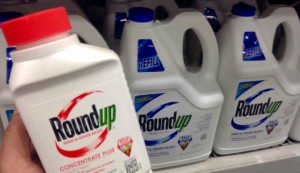19
Oct
Monsanto Faces Lawsuits on Cancer Linked to Roundup
(Beyond Pesticides, October 19, 2015) Monsanto, the major producer of Roundup (glyphosate), has found itself in hot water recently, as personal injury lawsuits pile up over the link between glyphosate exposure and non-Hodgkin’s Lymphoma (NHL). Personal injury law firms around the U.S. have found a multitude of plaintiffs and are preparing for what could be a “mass tort” action against Monsanto for knowingly misinforming the public and farmworkers about the dangers of the chemical.
 The latest lawsuit was filed October 14 in Delaware Superior Court by three law firms representing three plaintiffs. One plaintiff in the Delaware lawsuit, Joselin Barrera, 24, a child of migrant farmworkers, relates her non-Hodgkin lymphoma (NHL) to glyphosate exposure. Elias de la Garza, a former migrant farm worker and landscaper diagnosed with NHL, has a similar claim. These follow other lawsuits filed last month in New York and California that accuse Monsanto of knowing that glyphosate was hazardous to human health. Monsanto “led a prolonged campaign of misinformation to convince government agencies, farmers and the general population that Roundup was safe,” the lawsuit states.
The latest lawsuit was filed October 14 in Delaware Superior Court by three law firms representing three plaintiffs. One plaintiff in the Delaware lawsuit, Joselin Barrera, 24, a child of migrant farmworkers, relates her non-Hodgkin lymphoma (NHL) to glyphosate exposure. Elias de la Garza, a former migrant farm worker and landscaper diagnosed with NHL, has a similar claim. These follow other lawsuits filed last month in New York and California that accuse Monsanto of knowing that glyphosate was hazardous to human health. Monsanto “led a prolonged campaign of misinformation to convince government agencies, farmers and the general population that Roundup was safe,” the lawsuit states.
Glyphosate is touted as a “low toxicity” chemical and “safer” than other chemicals by the Environmental Protection Agency (EPA) and industry and is widely used in food production and on lawns, gardens, parks, and children’s playing fields. However, the International Agency for Research on Cancer (IARC), which is a part of the World Health Organization) released its finding in March, concluding that there is sufficient evidence of carcinogenicity based on laboratory studies. IARC’s classification of glyphosate as a Group 2A “probable” carcinogen finds that glyphosate is anything but safe. The ranking represents the highest order carcinogen when no human data is available —and since chemicals are not tested on humans, a higher ranking is rare. According to IARC, Group 2A means that the chemical is probably carcinogenic to humans based on sufficient evidence of carcinogenicity in experimental animals. The agency considered the findings from an EPA Scientific Advisory Panel report, along with several recent studies in making its conclusion. The agency also notes that glyphosate caused DNA and chromosomal damage in human cells. Further, epidemiologic studies have found that exposure to glyphosate is significantly associated with an increased risk of non-Hodgkin’s lymphoma. Following IARC’s review, California Environmental Protection Agency’s Office of Environmental Health Hazard Assessment (OEHHA) announced that it intended to list glyphosate and three other chemicals as cancer-causing chemicals under California’s Safe Drinking Water and Toxic Enforcement Act of 1986 (Proposition 65).
EPA, in 1985, originally classified glyphosate as ”˜possibly carcinogenic to humans’ based on tumors in laboratory animals, but changed its classification to evidence of non-carcinogenicity in humans years later, most likely due to industry influence, allowing the chemical to be the most widely used pesticide in the U.S. USDA has contributed to its greatly expanded use by deregulating crops, including the vast majority of corn and soybeans, that are genetically engineered to be tolerant to the chemical. In recent years, weeds have exhibited resistance to glyphosate and its efficacy has been called into question. Additionally, the U.S. Geological Survey (USGS) routinely finds glyphosate in U.S. waterways especially in the Midwestern states and the Mississippi River valley. Ecological data also reports that glyphosate and glyphosate formulated products are toxic to aquatic organisms, and is extremely lethal to amphibians.
The mounting evidence of glyphosate’s hazards is piling up and environmental groups, like Beyond Pesticides, are urging localities to restrict or ban the use of the chemical. A recent success in grassroots activism comes through Tracy Madlener, a mother of two, who got her neighborhood in Laguna Hills, California to eliminate the use of the widely-used weedkiller. Beyond Pesticides promotes these actions and many more through our Tools for Change page. This page is designed to help activists and other concerned citizens organize around a variety of pesticide issues on the local, state, and national level. Learn how to organize a campaign and talk to your neighbors about pesticides with our factsheets.
Another way to avoid glyphosate and other harmful pesticides is to support organic agriculture and eat organic food. Beyond Pesticides has long advocated for organic management practices as a means to foster biodiversity, and research shows that organic farmers do a better job of protecting biodiversity than their chemically-intensive counterparts. Instead of prophylactic use of pesticides and biotechnology, responsible organic farms focus on fostering habitat for pest predators and other beneficial insects, and only resort to judicious use of least-toxic pesticides when other cultural, structural, mechanical, and biological controls have been attempted and proven ineffective. For more information on why organic is the right choice, visit our Organic Agriculture webpage.
Sign the petition to ban glyphosate.
All unattributed positions and opinions in this piece are those of Beyond Pesticides.
Source: Reuters











Glyphosphate causes harm to our environment and to humans. It should have been banned years ago.
October 20th, 2015 at 2:39 pm